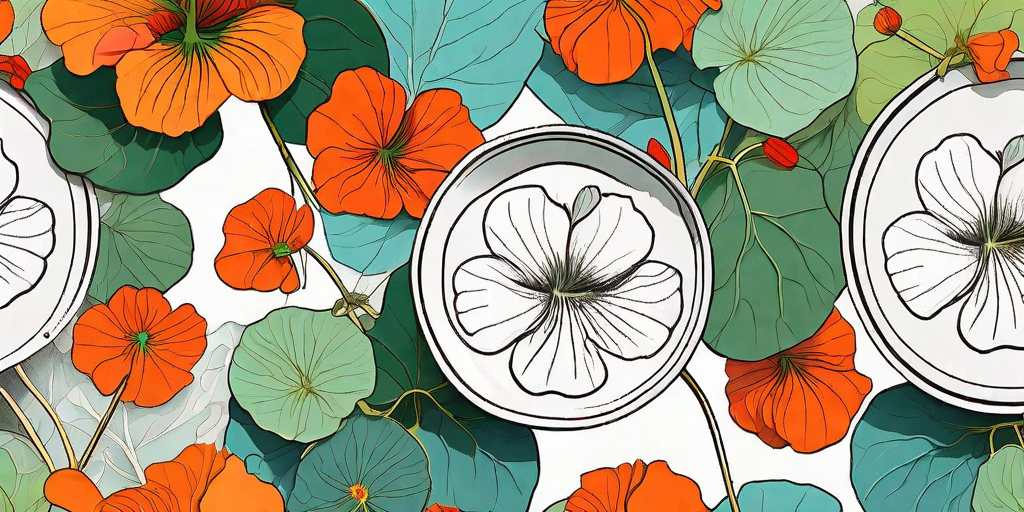
Welcome to the world of nasturtiums, where the flowers are as edible as they are beautiful. These vibrant, versatile plants are a gardener's dream and a chef's delight. They're easy to grow, hardy, and offer a peppery punch to your salads and dishes. So, let's dive into the world of nasturtiums and discover how they can brighten up your garden and your plate.
The Basics of Nasturtiums
What are Nasturtiums?
Nasturtiums are flowering plants that originate from South and Central America. They come in a variety of colors, from bright yellows and oranges to deep reds and maroons. But it's not just their looks that make them a garden favorite. Nasturtiums are also known for their peppery flavor, similar to watercress, making them a popular addition to salads and gourmet dishes.
There are two main types of nasturtiums: bush and trailing. Bush types are compact and perfect for small gardens or containers, while trailing types can spread up to six feet and are great for ground cover or hanging baskets. Both types produce the same vibrant, edible flowers.
Why Grow Nasturtiums?
Aside from their beauty and culinary uses, nasturtiums offer many benefits to your garden. They're known to deter pests like aphids, whiteflies, and squash bugs, making them a great companion plant. Plus, they're low maintenance and drought tolerant, making them a great choice for beginner gardeners or those with a less-than-green thumb.
Nasturtiums are also a great source of nectar, attracting pollinators like bees, butterflies, and hummingbirds to your garden. So, not only do they add color and flavor to your garden and plate, they also support local wildlife and biodiversity.
How to Grow Nasturtiums
Planting Nasturtium Seeds
Planting nasturtium seeds is a breeze. They're large and easy to handle, and they germinate quickly. Start by soaking the seeds overnight in water to speed up germination. Then, plant them about half an inch deep and 10 to 12 inches apart. They prefer full sun but can tolerate partial shade.
Nasturtiums aren't picky about soil, but they do best in well-drained soil. They're also one of those rare plants that thrive in poor soil, as rich soil tends to produce more leaves than flowers. So, hold back on the fertilizer and let them do their thing.
Caring for Nasturtiums
Once your nasturtiums are planted, they require very little care. Water them regularly, but be careful not to overwater as they're prone to root rot. If you notice the leaves turning yellow, it's a sign that they're getting too much water.
Pruning isn't necessary, but you can pinch back the stems to encourage bushier growth. And while nasturtiums are generally pest-free, keep an eye out for aphids. If you spot any, simply rinse them off with a blast of water from your hose.
Culinary Uses of Nasturtiums
Adding Nasturtiums to Your Plate
Nasturtiums are more than just a pretty face. They're also a tasty and nutritious addition to your meals. The leaves, flowers, and seeds are all edible and packed with vitamin C.
The flowers have a sweet, spicy flavor and make a colorful garnish for salads, pasta dishes, and desserts. The leaves can be used in salads or as a peppery addition to sandwiches. And the seeds? They can be pickled and used as a cheaper alternative to capers.
Recipes with Nasturtiums
Ready to get cooking with nasturtiums? Here are a few simple recipes to get you started:
- Nasturtium Salad: Mix a handful of nasturtium leaves and flowers with your favorite salad greens. Add some cherry tomatoes, cucumber, and a simple vinaigrette for a colorful, peppery salad.
- Nasturtium Pesto: Swap out basil for nasturtium leaves in your favorite pesto recipe. The result is a spicy, tangy pesto that's perfect for pasta, sandwiches, or as a marinade.
- Pickled Nasturtium Seeds: Pickle nasturtium seeds in vinegar and salt for a homemade version of capers. Use them in salads, pasta dishes, or as a garnish for fish.
FAQs about Nasturtiums
- Are nasturtiums annuals or perennials? Nasturtiums are typically grown as annuals, but they can be perennials in frost-free climates.
- Can nasturtiums grow in shade? While nasturtiums prefer full sun, they can tolerate partial shade. However, they may produce fewer flowers in shady conditions.
- Are nasturtiums deer resistant? Yes, nasturtiums are generally deer resistant, making them a good choice for gardens that are frequented by deer.
- Can I grow nasturtiums indoors? Yes, nasturtiums can be grown indoors in containers. They need plenty of light, so place them near a sunny window.
So, there you have it. Nasturtiums are a gardener's dream and a chef's delight. They're easy to grow, beautiful to look at, and delicious to eat. So why not give them a try? Your garden and your plate will thank you.















